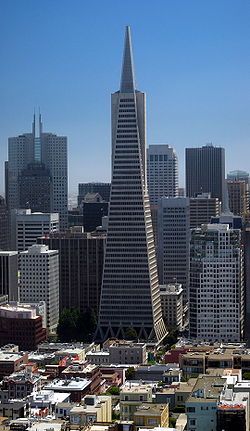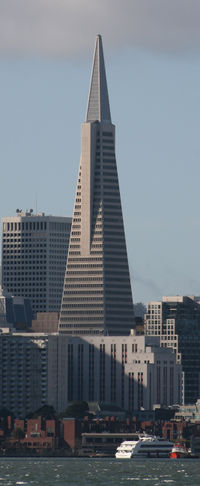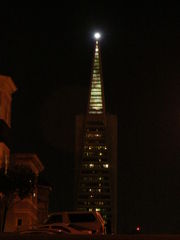Transamerica Pyramid
| Transamerica Pyramid |
 |
| Record height |
| Preceded by |
Bank of America Center |
| General information |
| Location |
600 Montgomery Street
San Francisco |
| Status |
Complete |
| Groundbreaking |
December 1969 |
| Constructed |
Summer 1972 |
| Use |
Commercial offices |
| Height |
| Roof |
260 m (850 ft) |
| Technical details |
| Floor count |
48 |
| Floor area |
530,000 sq ft (49,000 m2) |
| Elevators |
18 |
| Cost |
US$32,000,000 |
| Companies involved |
| Architect(s) |
William L. Pereira |
| Structural engineer |
Chin & Hensolt, Inc.
Glumac International
Simonson & Simonson |
| Contractor |
Dinwiddie Construction Co. |
| Owner |
Transamerica Corporation |
| Management |
Cushman & Wakefield |
| References: [1][2][3] |
The Transamerica Pyramid is the tallest and most recognizable skyscraper in the San Francisco skyline. Although the building no longer houses the headquarters of the Transamerica Corporation, it is still strongly associated with the company and is depicted in the company's logo. Designed by architect William Pereira, at 260 m (850 ft), upon completion it was among the five tallest buildings in the world.[4]
History
Built on the location of the historic Montgomery Block, it has a structural height of 260 m (850 ft) and contains 48 floors of retail and office space. Construction began in 1969 and finished in 1972. Transamerica moved their headquarters to the new building from across the street, where they used to be based in another flatiron-shaped building now occupied by the Church of Scientology of San Francisco.
Although the tower no longer serves as the Transamerica Corporation headquarters, it is still strongly associated with the company and is depicted in the company's logo. The building is evocative of San Francisco and has become one of the many symbols of the city.[5] Designed by architect William Pereira, it faced considerable opposition during its planning and construction, and was sometimes referred to by detractors as "Pereira's Prick".[6]
The Transamerica Pyramid was the tallest skyscraper west of the Mississippi from 1972 to 1974 surpassing the then Bank of America Center. It was then later surpassed by the Aon Center in Los Angeles.
The building is considered to have been the intended target of a foiled terrorist attack, involving the hijacking of airplanes as part of the Bojinka plot, which was foiled in 1995.[7]
In 1999, Transamerica was acquired by Dutch insurance company AEGON. When the non-insurance operations of Transamerica were later sold to GE Capital, AEGON retained the building as an investment.[5]
Design
The land use and zoning restrictions for the parcel limited the number of square feet of office that could be built upon the lot, which sits at the northern boundary of the financial district. This building was built under the 'Building Codes' to be Earthquake safe.
The building is a tall, four-sided pyramid with two "wings" on either side to accommodate an elevator shaft on the east and a stairwell and a smoke tower on the west. The top 64.6 m (212 ft) of the building is the spire. There are four cameras pointed in the four cardinal directions at the top of this spire forming a virtual observation deck. Four monitors in the lobby, whose direction and zoom can be controlled by visitors, display the cameras' views 24 hours a day. An observation deck on the 27th floor was closed after the September 11, 2001 attacks, and replaced by the virtual observation deck. The top of the Transamerica Pyramid is covered with aluminum panels. During the holiday season of Thanksgiving, and 4 July, a bright, white light is seen on top of the pyramid.
Specifications

As viewed from Treasure Island
- The building's façade is covered in crushed quartz, giving the building its pure white color.
- The four-story base of the building contains a total of 16,000 cu yd (12,000 m3) of concrete and over 300 mi (480 km) of steel rebar .
- It has 3,678 windows.
- The building's foundation is 9 feet (2.7 m) thick and was the result of a 24-hour continuous concrete pour.
- Only two of the building's 18 elevators reach the top floor.
- The original proposal called for a 1,150 ft (350 m) building, which would have been for one year the second-tallest completed building in the world. The proposal was rejected by the city planning commission on the grounds that it would have interfered with views of San Francisco Bay from Nob Hill.[4]
- The building occupies the site that was the temporary home of A.P. Giannini's Bank of Italy after the 1906 San Francisco earthquake destroyed its office. Giannini founded Transamerica in 1928 as a holding company for his financial empire. Bank of Italy later became Bank of America.
- There is a plaque commemorating two famous dogs, Bummer and Lazarus, at the base of the building.
- The hull of the whaling vessel Niantic, an artifact of the 1849 California Gold Rush, lay almost exactly beneath the Transamerica Pyramid, and the location is marked by a historical plaque outside the building (California Historical Landmark #88).
- The aluminum cap is indirectly illuminated from within to balance the appearance at night.
- The two vertical external extensions allow preservation of useful interior space at the upper levels. One extension is the top of elevator shafts while the other is a smoke evacuation tower for fire-fighting.[8]
- A glass pyramid cap sits at the top and encloses both aircraft warning light and a seasonal white beacon.
- At certain times of the year the glass cap will briefly cast a reflected sunlight gleam onto traffic crossing the San Francisco – Oakland Bay Bridge

Bright light at the pinnacle and indirect internal top illumination
See also
References
External links
|
Timeline of the tallest buildings west of the Mississippi |
|
Central Tower (91 m) (1898) · Key Bank Center (71 m) (1911) · Smith Tower (141 m) (1914) · Kansas City Power and Light Building (145.1 m) (1931) · Mercantile National Bank Building (166 m) (1942) · Republic Center (183 m) (1954) · Sheraton Dallas Hotel (183 m) (1959) · ExxonMobil Building (185 m) (1963) · Elm Place (191 m) (1965) · 555 California Street (237 m) (1969) · Transamerica Pyramid (260 m) (1972) · Aon Center (262 m) (1973) · JPMorgan Chase Tower (305 m) (1982) · U.S. Bank Tower (310 m) (1990)
|
|
|
Timeline of the tallest buildings in California |
|
Mills Building (47 m) (1892) · Central Tower (91 m) (1898) · San Francisco City Hall (94 m) (1915) · Commercial Union Assurance Building (94 m) (1921) · 225 Bush Street (100 m) (1922) · PacBell Building (133 m) (1925) · Russ Building (133 m) (1927) · Los Angeles City Hall (138 m) (1928) · Hartford Building (142 m) (1965) · 44 Montgomery (172 m) (1967) · Bank of America Center (237 m) (1969) · Transamerica Pyramid (260 m) (1972) · Aon Center (262 m) (1973) · U.S. Bank Tower (310 m) (1990)
|
|
|
Timeline of the tallest buildings San Francisco |
|
Mills Building (47 m) (1892) · Central Tower (91 m) (1898) · San Francisco City Hall (94 m) (1915) · Commercial Union Assurance Building (94 m) (1921) · 225 Bush Street (100 m) (1922) · PacBell Building (133 m) (1925) · Russ Building (133 m) (1927) · Hartford Building (142 m) (1965) · 44 Montgomery (172 m) (1967) · Bank of America Center (237 m) (1969) · Transamerica Pyramid (260 m) (1972)
|
|
|
Tallest buildings in San Francisco |
|
Skyscrapers over
500 ft (150 m) |
Transamerica Pyramid · 555 California Street · 345 California Center · Millennium Tower · One Rincon Hill South Tower · 50 Fremont Center · 101 California Street · Chevron Tower · Four Embarcadero Center · One Embarcadero Center · 44 Montgomery · One Market Plaza Spear Tower · One Sansome Street · Shaklee Terraces · First Market Tower · McKesson Plaza · 425 Market Street · Post Montgomery Center · 333 Bush Street · Hilton San Francisco Union Square Tower I · Pacific Gas & Electric Building
|
|
Highrises over
300 ft (90 m) |
50 California Street · St. Regis Museum Tower · 100 McAllister Street · 100 Pine Center · 45 Fremont Center · 333 Market Street · 650 California Street · 555 Mission Street · 100 First Plaza · One California · San Francisco Marriott Marquis · Russ Building · PacBell Building · JP MorganChase Building · The Paramount · Providian Financial Building · Three Embarcadero Center · Two Embarcadero Center · 595 Market Street · 123 Mission Street · 101 Montgomery · Embarcadero West · California Automobile Association Building · Four Seasons Hotel · One Maritime Plaza · Westin St. Francis · Shell Building · Westin San Francisco Market Street · Hilton San Francisco Financial District · One Market Plaza Steuart Tower · 199 Fremont Street · 425 California Street · Grand Hyatt San Francisco · The Infinity I · 100 Montgomery Street · Fox Plaza · InterContinental San Francisco · 101 Second Street · 580 California Street · The Infinity II · 601 California Street · Hilton San Francisco Union Square Tower II · 450 Sutter Street · Stevenson Place · KPMG Building · 150 California Street · 225 Bush Street · 505 Montgomery Street · Bechtel Building · Bank of California Building · Fairmont San Francisco · 180 Montgomery Street · Central Plaza · The Summit · W San Francisco · Phillip Burton Federal Building · 555 Market Street · One Bush Plaza · Hunter-Dulin Building · Mills Tower · San Francisco City Hall · Central Tower
|
|
| Planned and proposed |
Transbay Transit Center & Tower, Renzo Piano Towers I & II · 181 Fremont Street · Palace Hotel Residential Tower · Harbor Village Resort · 350 Mission Street · 509 Howard Street · One Rincon Hill North Tower · Treasure Island development · 201 Folsom Street I & II · 45 Lansing Street · The Californian at Rincon Hill · 340-350 Fremont Street · 555 Washington · 10th and Market · California Pacific Van Ness Hospital · 524 Howard Street
|
|
| See also: San Francisco's tallest buildings |
|
|
San Francisco attractions |
|
| Landmarks |
49-Mile Drive · Alcatraz · Bay Bridge · Cable Cars · The Castro · Chinatown · City Hall · Cliff House · Coit Tower · F-Market Streetcar · Fairmont Hotel · Federal Reserve Bank · Ferry Building · Fisherman's Wharf · Fort Mason · Fort Point · Ghirardelli Square · Golden Gate Bridge · Grace Cathedral · Haight-Ashbury · Jack Kerouac Alley · Lombard Street · Market Street · Mission Dolores · Nob Hill · North Beach · Old U.S. Mint · Painted Ladies · Palace of Fine Arts · Pier 39 · Public Library · Sutro Baths · Transamerica Pyramid · Treasure Island · Union Square
|
|
| Museums & art |
Asian Art Museum · Aquarium of the Bay · Cable Car Museum · California Academy of Sciences · Palace of the Legion of Honor · Cartoon Art Museum · Chinese Historical Society Museum · Conservatory of Flowers · Contemporary Jewish Museum · de Young Museum · Exploratorium · Haas-Lilienthal House · International Museum of Women · Musée Mécanique · Museo ItaloAmericano · Museum of Performance & Design · Museum of the African Diaspora · Precita Eyes · Randall Museum · Ripley's Believe It or Not! · SFMOMA · San Francisco Maritime · Railway Museum · USS Pampanito · Wattis Institute for Contemporary Arts · Zeum
|
|
| Recreation & parks |
Alamo Square · Angel Island · Candlestick Point · Corona Heights · Crissy Field · Dolores Park · Farallon Islands · Glen Canyon · Golden Gate National Recreation Area · Golden Gate Park · Lake Merced · McLaren Park · Mount Davidson · Ocean Beach · The Presidio · San Francisco Zoo · Stern Grove · Twin Peaks · Yerba Buena Gardens
|
|
| Entertainment |
American Conservatory Theater · Bill Graham Civic Auditorium · Cow Palace · The Fillmore · Festivals and fairs · War Memorial and Performing Arts Center · Yerba Buena Center for the Arts
|
|
| Higher education |
UCSF · UC Hastings · San Francisco State · University of San Francisco · City College of San Francisco
|
|
| Sport |
|
|
| Food & drink |
Anchor Steam · Boudin Bakery · Cioppino · Dungeness crab · Ghirardelli · It's-It Ice Cream · Mission burrito · Rice-A-Roni · Sourdough bread (Lactobacillus sanfranciscensis) · Tonga Room & Hurricane Bar · Top of the Mark
|
|
| Commerce |
Bechtel · Charles Schwab · Financial District · Gap · McKesson · Metreon · Moscone Center · PG&E · Stonestown Galleria · Wells Fargo · Westfield San Francisco Centre
|
|

